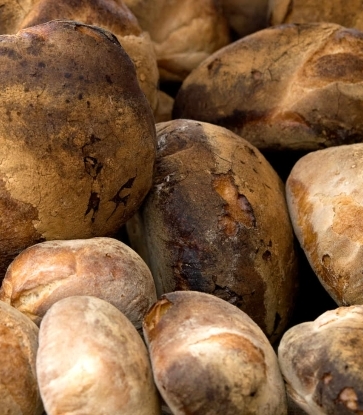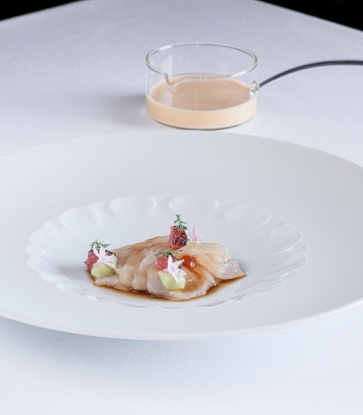For chef Paul Buttigieg, it's business as usual. He selects fish from the daily catch brought in by fishermen based on how easy they are to fillet and their commercial viability for use in his restaurant. Popular fish such as sea bream and John Dory can easily be cooked whole on the barbecue, al cartoccio ("en papillotte") or in a salt crust. He also makes a point of buying up some of the "less interesting" fish, which are just as flavoursome, but all the bones make them less popular with the average consumer for practical reasons: "Like vopi, a kind of sea bass – boops boops in English – a bony fish that people readily prepare at home but don't expect at restaurants," he says.
He inherited his passion for running a restaurant from his parents. As a young boy, he would watch his mother, Jane, working enthusiastically in the kitchen and his father, Leli, welcoming diners front-of-house. The couple first opened Tmun Restaurant in Xlendi in 1987, before moving it to its current location in Mgarr Harbour close to the Gozo Ferry Terminal in 2009. He took over the family restaurant from his parents, who had instilled in him a preference for working with local produce. Picture baskets full of small fish. This is bycatch that the Maltese fishermen he works with do not throw back into the water as worthless, but instead bring ashore because they know that chefs like Paul Buttigieg are willing to pay for it. "It's an approach based on mutual respect, and it allows us to put that part of the catch to good use in the kitchen," he stresses. "I use this bycatch as a base for sauces and to make a flavoursome soup in the style of a rich bouillabaisse. A hearty soup with pieces of fish from the day's catch. Of course, such a hearty soup is more in demand in colder weather, but it's popular in summer, too."

The practice of making optimum use of the catch and minimising waste makes Paul Buttigieg in Malta an example to follow. What sets his approach apart entirely is his interest in utilising certain fish species that are usually sold only as bait. Mackerel (kavalli in Maltese), for instance, is sold as bait in Malta for five euros a kilo. On the Maltese islands, this fish is still not considered fit for human consumption, which is curious in light of its popularity in other parts of the world. When it comes to smoked fish, mackerel is perhaps one of the most widely eaten species. Mackerel can be tinned with herbs and sauce, and French cuisine features some delicious dishes featuring young mackerel (‘lisette’ in French). Sushi and sashimi made with mackerel have also become increasingly popular outside Japan, and enthusiasts now recognise ‘saba’ by its Japanese name. Malta does not have a large-scale fish processing industry and this, too, may be a factor in the culinary potential of a fish like mackerel remaining under the radar.
"This is a shame, because mackerel is abundantly available almost every week of the year. I like to introduce the fish to my diners in different ways, for example, as ceviche, cold-cooked or hot with the skin lightly charred. My local patrons are surprised to learn that mackerel has economic value beyond being used as bait. Once they taste the fish, they are quickly convinced of its culinary value. I have even had diners come back for it specifically and ask unprompted for a dish with mackerel. Foreigners who are familiar with the exquisite taste and fine texture of mackerel are also enthusiastic." Paul Buttigieg proves that those who are creative and dare to push boundaries can be successful even with unknown, unloved and cheap fish species – and at the same time, this can contribute to the promotion of sustainable and more diverse fishing, which can reduce overfishing of certain species.

However, Paul Buttigieg is pragmatic enough not to rely solely on unknown fish species to enhance the value, flavour and form of his culinary repertoire. "I strive to create a balance on my menu between dishes featuring popular fish and underappreciated species. We use the well-known species to attract diners and then introduce them to lesser-known fish. You can't have one without the other. A balanced selection is important. That also goes for the range of dishes. For local patrons, I prepare fish whole, as they now expect to see fish whole beforehand to check its freshness, whereas tourists prefer to be served boneless fillets." Inspired by renowned Australian chef Josh Niland, known for his gill-to-fin cooking, Paul Buttigieg utilises not only the conventional cuts of fish.
"Certain parts of cuttlefish, itself an undervalued species of squid, are less popular with diners, but that does not stop me from incorporating them into a tasty filling for tortellini, for example. Just because guests do not know about certain fish, it doesn’t mean we shouldn't use them." He also understands the power of using certain popular types of fish to attract diners to his restaurant. One example is wreckfish (also known as dott cawlun), which is an overfished species of grouper that he serves in an Asian-inspired dish. To be able to promote undervalued fish as an ambassador and to play a role as a chef committed to sustainable practices, a well-known and well-run restaurant is an important tool for raising awareness of the concept of future-proof fishing. "In that sense, there are still many challenges ahead, such as making my own garum from fish scraps or making katsuobushi instead of working with imports from Japan," says Paul Buttigieg. Every day brings the challenge of balancing what's feasible and sustainable with what diners expect, all to keep them coming back for more.

Part of the MICHELIN Guide Malta selection since 2020, Tmun is one of only a handful of restaurants on Gozo to have made the cut. Beyond showcasing local and creative cuisine, the restaurant prioritises understanding the desires of both local and international diners. Although the menu predominantly features fish dishes, there are also a number of meat options and four plant-based creations. Wine lovers can indulge in an extensive and diverse selection of wines from around the globe, which includes many established labels alongside sparkling, white, rosé, red and exquisite sweet wines from Malta and Gozo.












